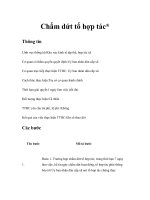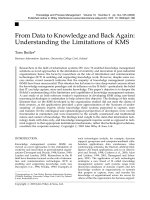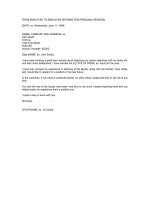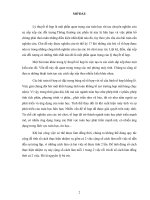Tài liệu From School to Higher Education? doc
Bạn đang xem bản rút gọn của tài liệu. Xem và tải ngay bản đầy đủ của tài liệu tại đây (1.18 MB, 10 trang )
Free download from www.hsrc
p
ress.ac.za
Compiled by the Research Programme on Human Resources Development, Human
Sciences Research Council (Executive Director: Dr Andre Kraak)
Published by the Human Sciences Research Council Publishers
Private Bag X9182, Cape Town, 8000, South Africa
© Human Sciences Research Council 2002
First published 2002
All rights reserved. No part of this book may be reprinted or reproduced or utilised in
any form or by any electronic, mechanical, or other means, including photocopying and
recording, or in any information storage or retrieval system, without permission in writing
from the publishers.
ISBN 0-7969-2005-2
Cover design by FUEL Design
Produced by comPress
Distributed in South Africa by Blue Weaver Marketing and Distribution,
P.O. Box 30370, Tokai, Cape Town, South Africa, 7966. Tel/Fax: (021) 701-7302,
email:
Free download from www.hsrc
p
ress.ac.za
This report is the culmination of a process in which a dedicated project team in the
Research Programme on Human Resources Development (HRD) at the Human Sciences
Research Council (HSRC) was involved. I should like to pay tribute to the following team
members:
• Jacques du Toit for research and instrument design; sampling; questionnaire
piloting; fieldwork conceptualisation and fieldworker training; survey logistics
management; data capture management and analysis.
• Dr Andre Kraak for project conceptualisation; research and instrument design.
• Lindi Basson for project, fieldwork, and financial administration; fieldwork
conceptualisation; fieldworker recruitment and management; survey logistics
management.
• Mariette Visser for sampling; schools database management.
• Dr Tom Magau for instrument design; fieldworker training; fieldwork
administration of questionnaires; questionnaire tallying.
• Mmamajoro Shilubane for instrument design; fieldworker training; questionnaire
tallying.
• Dr Isaac Ntshoe for questionnaire tallying.
• Salim Akoojee for questionnaire tallying.
In addition, I should like to thank:
• Dr Jacques Pietersen, chief statistician in the Research Programme on Surveys,
Analyses, Modelling and Mapping at the HSRC, for his assistance in designing and
drawing the sample for the survey, weighting the data, conceptualising the
CHAID and regression analyses, and assisting in the interpretation of the findings;
• Dr Andre Kraak, Executive Director of the Research Programme on Human
Resources Development, for his critical insights into key issues raised by the find-
ings of the report;
• Debbie Budlender, Principal Researcher at the Community Agency for Social
Enquiry (CASE), for the very helpful advice on statistical interpretation and
expression proffered in her critical reading of the report; and
• Jane Hendry, Institutional Planner in the Institutional Planning Department,
University of Cape Town, for her invaluable comments on the report from a
higher education perspective.
Finally, I should like to express my thanks to all those whose involvement in the project
before and during the fieldwork stage made this study possible:
• Prof Peter Maassen, Director of the Higher Education Development Association
(Hedda) at the University of Oslo, for providing the initial impetus for the study;
• Dr Nico Cloete, Director of the Centre for Higher Education Transformation
(CHET), for facilitating the commissioning of the HSRC to undertake the research;
• The Higher Education Branch of the Department of Education – in particular, its
Deputy Director-General, Nasima Badsha, for her continuous support of the
project;
• The nine provincial education departments, for giving us access to schools;
• The 288 schools nationwide that allowed us to survey their Grade 12 learners;
and
• The 12 204 respondents to the survey.
Michael Cosser
Project Manager
Acknowledgements
Free download from www.hsrc
p
ress.ac.za
Free download from www.hsrc
p
ress.ac.za
With the transition to democratic rule in South Africa in 1994 came the expectation of
increased participation in the public higher education system as learners seemed set to
embrace the opportunity to access higher learning. Instead, the public higher education
system saw a levelling off in headcount enrolments through the latter half of the nineties,
with an actual decline in enrolments in the last two years of the decade.
The South African higher education participation rate of between 15% and 18% is below
the 20% benchmark given for developing middle-income countries. The National Plan for
Higher Education observes that there appear to be several factors producing a low
participation rate and low retention rate:
• Poor throughput rates in secondary schools;
• A fall in the retention rate in higher education;
• A shift in interest from public to private higher education (a growing number of
learners are pursuing qualifications in the private sector that are perceived to
present immediate employment opportunities);
• High drop-out rates for reasons either of student inability to continue financing
their studies or of academic exclusion; and
• A decline in student entries into postgraduate study programmes directly after
their completion of undergraduate programmes.
There is clearly a need for in-depth research on these phenomena.
Within this context, a key objective articulated in the National Plan is the intention to
shift the balance in enrolments from the Humanities – the traditional catchment area for
black and women students – to Business & Commerce and Science, Engineering &
Technology. This objective seeks to meet the labour market demand for larger numbers
of skilled graduates in these scarce-skill fields. Low enrolments in these fields are
attributable to the dearth of matriculants with the required proficiency in Mathematics and
also to the inadequacy of career counselling programmes in schools. Research is required
to provide an understanding of what factors underpin these conditions.
The critical constituency in this domain is, of course, the students themselves. Thus far,
very little attention has been given to how they make their decisions regarding options
for higher education. Phase One of the HSRC’s Student Choice Behaviour project aims to
secure an understanding of the factors affecting Grade 12 learners’ choices of higher
education institution and field of study. The findings of the study confirm and also
overturn popular assumptions about how and why young South Africans make the
choices they do.
The study concludes with a number of recommendations, inter alia, that:
• Parents and schools seek to provide learners with effective career counselling;
• The Education Ministry increase financial support for eligible higher
education candidates;
• The Education Ministry prioritize the establishment of a National Higher
Education Information and Applications Service to serve as an applications
clearing house; and
• The Education Ministry take learner choices of institutions into careful
account in its restructuring of the higher education landscape.
Foreword
Free download from www.hsrc
p
ress.ac.za
There is also a critical need to promote the image of the teaching profession amongst
school learners in the light of the very small interest in enrolling in the field of Education,
Training and Development evinced by the survey respondents.
I commend the project team for a carefully executed study, and echo the observation by
critical readers of the report that higher education planners and policy makers at the
national and the institutional level will find it a valuable contribution to understanding
how patterns of student choice determine flows between further education and training
(FET) and higher education.
Dr Andrew Paterson
Acting Executive Director
Research Programme on Human Resources Development
Human Sciences Research Council
Free download from www.hsrc
p
ress.ac.za
List of Tables and Figures i
Executive Summary 1
Part One: Background to the Study 19
1 Origins and rationale of the study 20
2 Review of the literature 22
3 The research problem 27
4 The research design 31
Part Two: The Research Findings 41
5 Profile of the population 42
6 Learner choice: to study further or not 58
7 Choosing an institution 75
8 Choosing a field of study 104
9 The impact of choices on the future 114
10 Relative influence of factors on learner choice 117
Part Three: Looking Forward 128
11 Implications of the findings 129
12 Conclusion 138
References 140
Appendix: The Questionnaire 143
Contents
Free download from www.hsrc
p
ress.ac.za
List of Tables and Figures
List of Tables
3.1 Matrix of factors affecting learner choice with regard to HE 28
4.1 Provincial allocation of sample of 300 schools 33
4.2 Final allocation of sample of 300 schools 34
4.3 Summary of school and learner questionnaire response to Grade 12 Learner
Choice survey 36
5.1 Unweighted response to Grade 12 Learner Choice survey by province 42
5.2 Unweighted numbers of respondents to Grade 12 Learner Choice
survey by province and population group 42
5.3 Missing population group information in the Grade 12 Learner
Choice survey by province 42
5.4 Age of Grade 12 learners by category 43
5.5 Population group of Grade 12 learners 44
5.6 Grade 12 learner distribution by population group classification according to
previous departmental affiliation of schools 45
5.7 Language spoken most at home by Grade 12 learners 46
5.8 Categorization of education and income variables into an ordinal variable 48
5.9 Socio-economic status of Grade 12 learners by province 49
5.10 Cross tabulation of population group with socio-economic status 49
5.11 Highest level of education of father / male guardian 52
5.12 Highest level of education of mother / female guardian 52
5.13 Employment status of learners’ fathers 53
5.14 Employment status of learners’ mothers 53
5.15 Monthly income of learners’ fathers 54
5.16 Monthly income of learners’ mothers 55
5.17 Intention of Grade 12 learners to enter HE, by socio-economic status 56
5.18 Learners with student siblings or sibling graduates, by population group 56
5.19 Categorization of numbers of books in the home, by population group 57
6.1 Correlation between average Grade 11 symbol and learner intention to
enter HE 58
6.2 Factors affecting learner decision to enter HE within the next
three years, in descending order of effect 61
6.3 Factors affecting learner intention to enter HE, by population group 64
6.4 Strength of learner intention to enter HE 65
6.5 Factors affecting learner intention to enter HE in 2002, in
descending order of effect 65
6.6 Factors affecting learner intention to postpone HE study, in
descending order of effect 66
6.7 Factors affecting learner intention to enter HE in 2002, by
population group 67
6.8 Factors affecting learner decision not to enter HE, in
descending order of effect 68
6.9 Factors affecting learner decision not to enter HE, by
population group 70
6.10 Factors likely to affect learner decision to enter HE, in
descending order of effect 71
i
Free download from www.hsrc
p
ress.ac.za
ii
6.11 Factors likely to affect learner decision to enter higher education, by
population group 73
7.1 Learner choice of institution type, by average Grade 11 symbol 76
7.2 Factors affecting learner decision to study at a private institution, in
descending order of effect 77
7.3 Factors affecting learner decision to study at a private institution, by
population group 77
7.4 Reasons for learner decision to study via correspondence, by gender 79
7.5 Learner choice of institution for HE study, in descending order of
popularity by national preference 80
7.6 Learner choice of institution for HE study, by province, in descending
order of popularity 84
7.7 Five most popular institutions for HE study, by population
group, in descending order of popularity 89
7.8 Learner choice of institution for HE study, by institutional category and
population group – low SES 90
7.9 Learner choice of institution for HE study, by institutional category and
population group – middle SES 91
7.10 Learner choice of institution for HE study, by institutional category and
population group – high SES 91
7.11 Learner choice of institution for HE study by A- and B-average
Grade 11 symbol, in descending order of popularity according to total of
A- and B-average symbols 92
7.12 Learner reasons for not studying at institutions constituting their first choice,
in descending order of popularity of reason 94
7.13 Factors influencing learner choice of institution for HE study,
in descending order of extent of influence 95
7.14 Factors influencing learner choice of institution for HE study,
by population group 96
7.15 Closing dates for application to study at selected institutions in Gauteng 97
7.16 Multiple response profile for learner applications to HE institutions 98
7.17 Comparison of learner intention to enter public HE institutions
and learner applications to these institutions 99
7.18 Factors facilitating application to HE institutions, in descending
order of importance 101
7.19 Factors facilitating application to HE institutions, by population
group 102
8.1 Learner choice of HE field of study 104
8.2 Correlation between learner choices of fields of study and
National Plan fields in stated objective 105
8.3 Learner choice of field of study, by gender 107
8.4 Male learner choice of HE field of study, in descending order of
popularity 108
8.5 Female learner choice of HE field of study, in descending order
of popularity 108
8.6 Learner choice of field of study, by population group 109
8.7 Factors influencing learner choices of fields for HE study, in
descending order of effect 110
From School to Higher Education?
Free download from www.hsrc
p
ress.ac.za
iii
8.8 Factors influencing learner choices of fields for HE study, by
population group 112
9.1 Learner perceptions about future work situation, in descending order of
importance 114
9.2 Anticipated life situation of learners ten years hence, in descending order
of extent of likelihood 115
9.3 Learner perceptions of the socio-political situation in the country ten years
hence,in descending order of extent of agreement 116
10.1 Factors outside of Sections 3–6 of the questionnaire affecting learner
choice with regard to HE 118
10.2 Factors influencing the outcome of question 3.1 regarding intention to
enter higher education within the next three years, in descending order of
influence 119
10.3 CHAID analysis for question 3.1 – intention to enter HE within the next
three years 120
10.4 Factors influencing the outcome of question 5.6 regarding choice of
institution for HE study 122
10.5 Factors influencing the outcome of question 6.1 regarding learner
choice of field of study 125
List of Figures
5.1 Grade 12 learners by population group by former school affiliation 45
5.2 Distribution of Grade 12 learners by socio-economic status 48
6.1 Intention to enter HE within the next three years 58
6.2 Learner intention to enter HE within the next three years,
by population group 60
7.1 Learner intention to enter institution type 75
7.2 Learner choice of institution type, by population group 75
7.3 Reasons for learner decision to study via correspondence 78
List of Tables and Figures
Free download from www.hsrc
p
ress.ac.za









